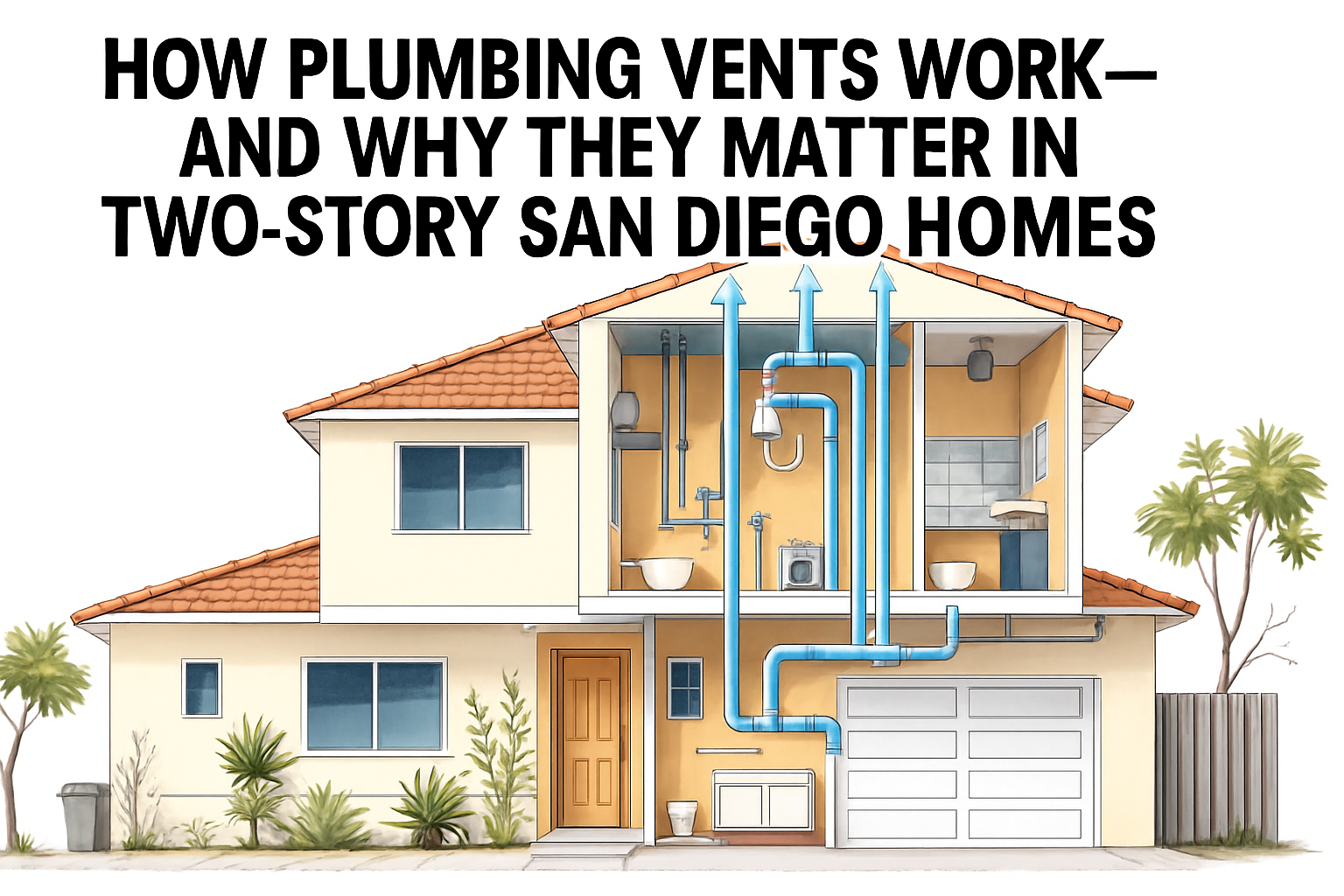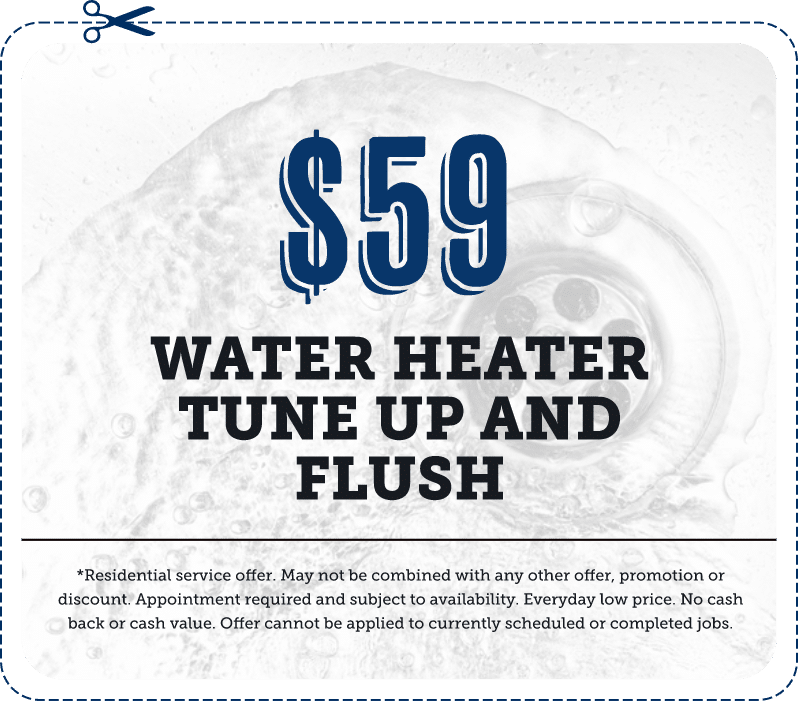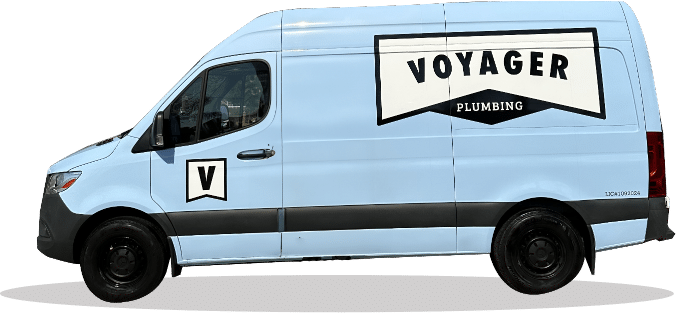Table of Contents
- Key Takeaways
- What Is a Plumbing Vent?
- How Plumbing Vents Work
- Why Plumbing Vents Matter More in Two-Story Homes
- Common Types of Plumbing Vents in San Diego Homes
- Signs That Something’s Wrong With Your Vent System
- What Causes Plumbing Vent Problems?
- Can You Add or Upgrade Plumbing Vents?
- How Voyager Plumbing Solves These Problems
- Why Plumbing Vents Deserve Attention
If you live in a two-story home in San Diego and you’re dealing with slow drains, gurgling toilets, or odd smells—your plumbing vents might be the hidden issue. Plumbing vents don’t get much attention, but they play a major role in keeping everything working right.
At Voyager Plumbing, we help homeowners across San Diego identify and fix vent problems before they turn into costly repairs. Let’s walk through how plumbing vents work—and why they matter even more in multi-story homes.
Have a concern already? Contact us today to schedule a plumbing inspection. We’ll handle the issue before it turns into something bigger.
Key Takeaways
- Plumbing vents regulate air pressure in drain systems, helping waste flow and blocking sewer gases.
- In two-story homes, poor venting can cause slow drains, bubbling toilets, and odors.
- San Diego homes—especially older ones—may need vent upgrades to meet modern demands.
- Common vent types include true vents, wet vents, and air admittance valves (AAVs).
- Voyager Plumbing inspects and fixes vent issues across San Diego with code-compliant solutions.
What Is a Plumbing Vent?
 A plumbing vent—also known as a vent stack—is a pipe that lets air into your plumbing system. It doesn’t carry water or waste. Instead, it balances air pressure, helps drains flow smoothly, and keeps sewer gases out of your living space.
A plumbing vent—also known as a vent stack—is a pipe that lets air into your plumbing system. It doesn’t carry water or waste. Instead, it balances air pressure, helps drains flow smoothly, and keeps sewer gases out of your living space.
Without airflow, water would drain slowly, traps could dry out, and sewer odors might enter your home. The vent pipe connects to your drain system and exits through your roof, allowing gases to escape while drawing in air to support proper flow.
How Plumbing Vents Work
Think of pouring soda from a bottle without allowing any air in—it flows unevenly and makes glugging noises. That’s how your plumbing would behave without vents.
As water moves through the drainpipes, air needs to enter the system to replace the space left behind. Plumbing vents allow this to happen, maintaining steady pressure and preventing suction that could empty water traps or slow drainage.
These vents also help water remain in the P-traps under your sinks, tubs, and floor drains. That water barrier prevents sewer odors from traveling up into your home.
Why Plumbing Vents Matter More in Two-Story Homes
Two-story homes in San Diego come with plumbing challenges that aren’t as common in single-story homes. Fixtures on upper floors—like toilets, tubs, and sinks—must push waste and water downward through a longer path. If the venting system isn’t sized correctly or placed well, it can lead to problems throughout the house.
You may hear bubbling sounds when you flush the toilet. Drains might run slowly, or worse—sewer odors could appear. These problems are often linked to venting issues, especially in homes where additions or remodels were completed without vent upgrades.
Homes built decades ago were not always designed for today’s plumbing demands. With more bathrooms, appliances, and water fixtures in use, older vent systems can easily fall short.
Common Types of Plumbing Vents in San Diego Homes
Here’s a look at the most common venting options found in local homes:
True Vent (Vent Stack)
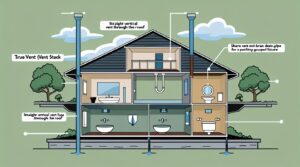 This is a vertical pipe that connects to a drain and runs straight up through the roof. It’s a direct and reliable way to vent a fixture.
This is a vertical pipe that connects to a drain and runs straight up through the roof. It’s a direct and reliable way to vent a fixture.
Wet Vent
A wet vent allows a single pipe to act as both a drain and a vent for multiple fixtures. It’s often used in bathrooms where sinks, toilets, and tubs are grouped together.
Air Admittance Valve (AAV)
This device allows air into the system when pressure drops but stays closed the rest of the time to prevent gas from escaping. AAVs are often installed where traditional roof vents aren’t possible, but they must be used appropriately and according to code.
Signs That Something’s Wrong With Your Vent System
Venting issues don’t always show up in obvious ways. They often hide behind symptoms that appear unrelated at first. Here are common signs your vents may not be working correctly:
- Gurgling sounds from drains or toilets
- Water that drains too slowly
- A toilet that bubbles when another fixture is used
- Odors from sinks, bathtubs, or laundry rooms
- Persistent clogs with no clear blockage
If you’ve noticed any of these, it’s worth getting your system checked. Voyager Plumbing can inspect your home’s plumbing vents and find the source of the issue.
What Causes Plumbing Vent Problems?
Plumbing vent issues can stem from many causes. Over time, roof vents can become blocked by leaves, bird nests, or debris. In older homes, pipes can corrode or develop gaps. Poor installation during a remodel might leave you with a system that doesn’t support current needs.
When new fixtures are added without upgrading the vent system, the pressure balance can get disrupted. This leads to issues that may affect more than one room or appliance.
If you’re dealing with unexplained plumbing trouble—especially in a home that’s been remodeled—your vent system is worth a closer look.
Can You Add or Upgrade Plumbing Vents?
Yes, and it’s common during renovations or repairs. If your current venting doesn’t support your plumbing system—or you’re planning to expand—it’s possible to add new vent lines or mechanical devices like AAVs to meet the demand.
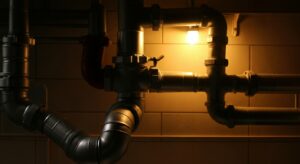 We typically make venting updates during:
We typically make venting updates during:
- Bathroom remodels or additions
- Kitchen or laundry room upgrades
- Attic, garage, or basement conversions
- Whole-home repiping projects
If your home hasn’t had plumbing work done in a while, or if you’re adding new fixtures, a vent check should be part of the plan.
How Voyager Plumbing Solves These Problems
With years of experience, Voyager Plumbing has seen just about every vent issue in San Diego homes. Whether your house is in Santee, North Park, La Mesa, or Clairemont, we understand the plumbing layouts in local neighborhoods.
We start with a full inspection. If there’s a problem, we’ll explain it clearly and provide options for correcting it. We use safe, proven solutions that match your home’s plumbing layout and current codes. There’s no guesswork—just solid, reliable repairs that last.
Why Plumbing Vents Deserve Attention
Plumbing vents may not be something you see every day, but they affect your entire home’s function. They help drains work as they should, keep gases sealed out, and protect your indoor air quality.
For two-story homes, the pressure and flow demands are higher, which means these systems must work harder. If your plumbing feels sluggish, loud, or inconsistent, the issue could be hiding in the venting system.
Let Voyager Plumbing take a look. We’ll check your vents, make sense of what’s happening, and help restore balance to your system.
Call us today or schedule online to book your plumbing inspection.

